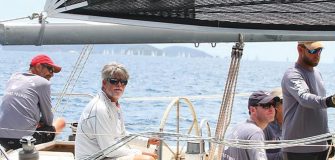Share
Just like the people of the VI are strong and resilient, so too are the reefs we depend so much on.
The power and fury unleashed by Hurricanes Irma and Maria in September 2017 were no doubt, apocalyptic. Very little was left untouched as could be seen all over the islands but what wasn’t so visible were the impacts inflicted underwater. While the hillsides are turning green again and people continue to rebuild their homes, businesses and lives, what is happening underwater was and continues to be just as dramatic.
The immediate impact of hurricanes on nearshore marine habitats is well documented and with waves reaching over 40ft in some areas during Irma, nearshore marine habitats had no protection from the violent scouring action on the seabed. The most fragile branching and soft corals didn’t stand much of a chance as they were ripped from the substrate. The amount of debris removed from coastlines by storm surge and wind has left the shallower underwater world looking similar to what hillsides looked like just after the storm. Even in deeper waters, many corals have been displaced and overturned. The bow of the RMS Rhone partially collapsed in around 80ft of water but surprisingly, most corals were intact and sea life was teaming just three weeks after Irma.
The orientation of our Territory’s islands and bays to intense incoming wave and wind energy from the hurricanes provided some protection and left many reefs with little damage. The deeper the reefs, the better their chances were to survive such powerful hurricanes. Many people may not even notice any reef damage since there is still plenty of other sea life. Most species can sense the oncoming storm and seek shelter in deeper waters then return after the storm. When they return, there is an abundance of food from the “restructured” reefs, even more dolphins than usual started appearing in our Territory’s water just weeks after the storms. More turtles are nesting because of the absence of electricity along nesting beaches where electricity has yet to be restored.
An impact that didn’t happen during the storms but about four weeks later was a red algal bloom composed of two different species. Not to be mistaken as a harmful algal bloom like red tide but nevertheless has a lingering impact on corals. It doesn’t appear because of runoff or increased nutrients in the water like most people would think, but extreme wave events trigger its mass reproduction. How long it lasts has yet to be seen but the longer the algae survives, the longer coral will not be able to recruit but in some cases, it has been documented to only last a few months. Once it disappears as quickly as it showed up, reefs will begin to regenerate but will take many years for corals to rebuild to its former structure.
No one thinks much about the marine life after a hurricane, but Nature has its own way of recovering without the help humans need after such an event. However, this doesn’t mean our marine resources don’t need a little “aid” or “relief”. The local non-profit organisation, Association of Reef Keepers (ARK), is working with the VI Government to remove some of the marine debris that litters the ocean floor. Leaving it would only result in even more damage to reefs as the winter swells will shift debris around, either shading corals from needed sunlight or crushing fragile coral tissue. ARK is also working on re-establishing the coral nurseries, thanks to the Coral Restoration Consortium, the US based Coral Restoration Foundation and Force Blue who have provided the assistance and materials needed to kick-start coral growth within the damaged near shore environments. Just like the people of the VI are strong and resilient, so too are the reefs we depend so much on.



